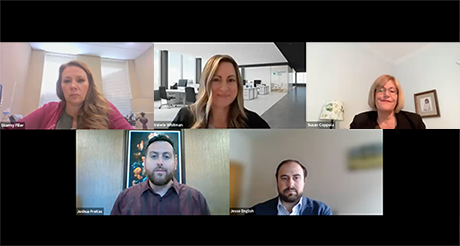Data on occupancy and expenses plays an invaluable role in helping operators understand their business. Still, that data often has a sizable blind spot inside the resident rooms.
That gap in knowledge was the topic of a webinar held Oct. 17, titled “Inside the Resident Room: In-Unit Data Helps Seniors Housing Operators Improve Safety & Increase Profitability.” Monitoring company EyeWatch LIVE sponsored the Seniors Housing Business webinar.
The panel of industry experts included Joshua Freitas, chief research officer, CERTUS Senior Living; Susan Coppola, founder and CEO, Benessere Health Advisory; Jesse English of Bowhead Specialty; Stormy Filler of Vitality Living; and Valerie Whitman, president and CEO, EyeWatch LIVE, who also moderated the discussion.
Whitman opened by showing data on how falls within resident rooms affect operators’ bottom lines while putting strain on the wider U.S. healthcare system.
“By 2030, 72 million older adults will experience a combined 52 million falls. Falls are the leading cause of fatal and non-fatal injuries. We know the impact that falls can have on residents — quality of life as well as where they choose to live, where they’re able to live and the impact on their families.”
For that reason, being able to predict and prevent falls can keep residents healthy and happy for longer while preventing costly liability lawsuits.
Freitas said his organization keeps close tabs on residents to know their tendencies on such a deep level that mitigation efforts can be put in place. For example, knowing what side of the bed a resident gets in and out of can lead to making that side more accessible to the resident. The room can be arranged so that getting in and out of bed is as easy as possible.
“From a proactive stance, it’s been great to see and predict things before they happen,” said Freitas. “To be able to have a live person notice when they’re getting close to the side of their bed lets us keep an eye on them and can drastically reduce the risk of them falling out of bed.”
Operators should also look at trends and build out policies to keep fall prevention as a top priority, added Freitas.
Staff members benefit
Filler noted that monitoring resident room data — and preventing falls — increases employee satisfaction. A resident falling is traumatic for both the senior and the staff tasked with assisting the senior, she noted.
“They can be in another room and know at least there’s a set of eyes on a resident that’s a fall risk,” said Filler. “It’s really helping out staff get peace of mind.”
Coppola added that the monitoring of rooms also helps prevent injuries to staff. For example, management can review a video of how a resident is lifted into bed and make sure staff members are using proper techniques to avoid hurting themselves.
“We’re beginning to see some other benefits to technology that helps us reaffirm our team members are doing things the way they need to for their own health,” said Coppola.
Those benefits to both residents and staff members all add up to a healthier business, concluded English.
“If employees are happy about caring for residents, it will further improve care outcomes. That keeps workers much more satisfied. There’s a really strong trickle-down effect for business resiliency.”
To view the full webinar, click here.
— Jeff Shaw

